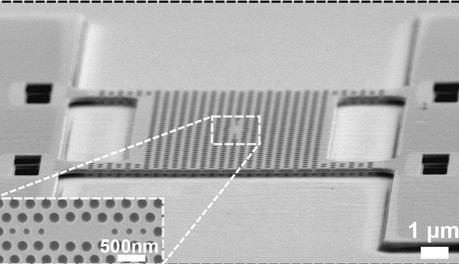Micro-spectrometer for smartphones
on

Spectrometry, the analysis of visible and invisible light has many applications. Every material and every structure has its own ‘fingerprint’ when considering the absorption and reflection of light, and can therefore be identified spectrometrically. Accurate spectrometers split the light using a prism or grid into different colors (frequencies), which are measured individually. Very accurate measurements are only possible multiple tens of centimeters after the splitting, when the different wavelengths are no longer overlapping each other. Spectrometers are therefore large pieces of equipment.
Microsensor
However, researchers from the TU Eindhoven, under the leadership of professor Andrea Fiore and senior lecturer Rob van der Heijden, developed an ingenious sensor that operates in a completely different way but provides similarly accurate measurements. For this they developed a special ‘photonic crystal cavity’, a ‘trap’ a mere few micrometers in size from which incident light cannot escape. This trap is in a membrane, in which the trapped light generates a small electrical current; this current is subsequently measured.
MEMS
Doctoral candidate Žarko Zobenica made this cavity extremely accurately: it only captures the light of a very narrow frequency range. To be able to measure a wider frequency range, the researchers placed two of these membranes close above each other. The two membranes affect each other: changing the separation between them a tiny amount also shifts the light frequency that the sensor observes. That is why the researchers added in a MEMS (micro electromechanical system). This mechanism can change the separation between the membranes and with that the measured frequency. In this way the sensor is able to cover a range of about thirty nanometers. Within this range the spectrometer can distinguish some hundred thousand (!) individual frequencies.
Future work
To demonstrate its usefulness, the researchers built several applications, including a gas sensor. Professor Fiore expects that the new spectrometer will take five years or more before it will be introduced into smartphones, because the frequency range that is covered is currently still too small. His group will therefore work on widening the observable spectrum. The expectation is that the micro-spectrometers will ultimately become just as important a feature in smartphones as the camera, because of the innumerable application possibilities, of which CO2 and smoke detection are two of the most obvious. The researchers have presented their invention in the publication Nature Communications.


Discussion (0 comments)